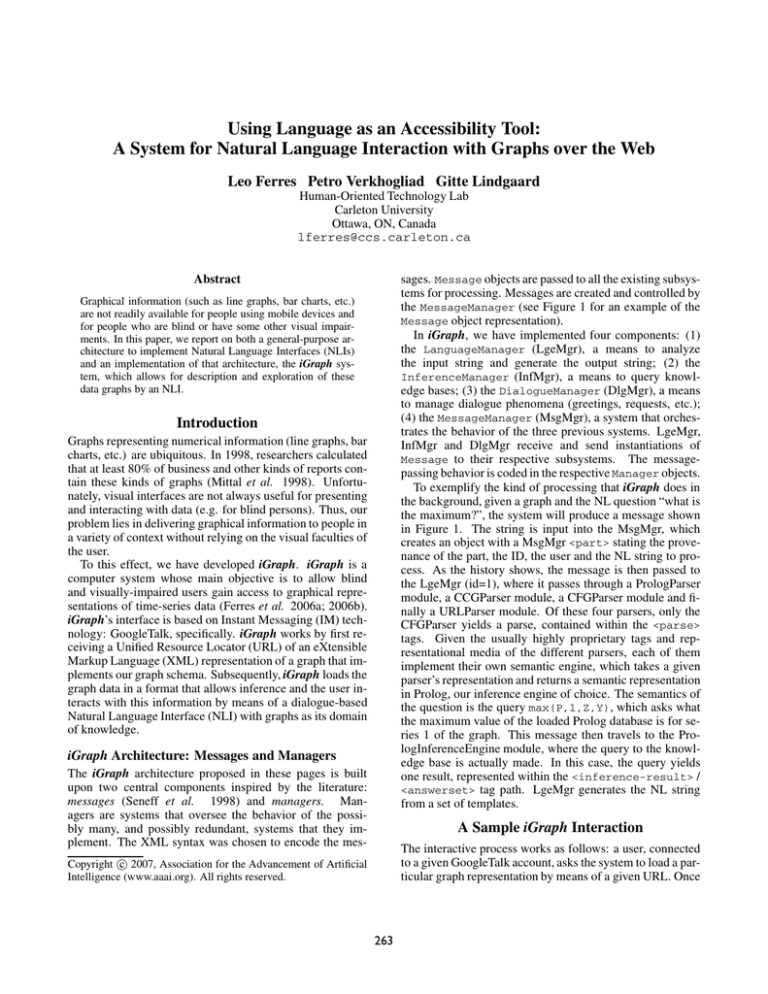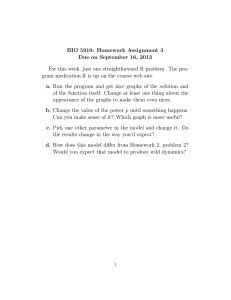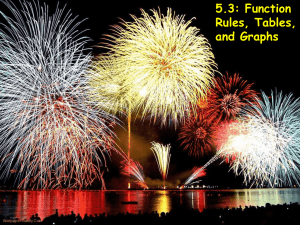
Using Language as an Accessibility Tool:
A System for Natural Language Interaction with Graphs over the Web
Leo Ferres Petro Verkhogliad Gitte Lindgaard
Human-Oriented Technology Lab
Carleton University
Ottawa, ON, Canada
lferres@ccs.carleton.ca
sages. Message objects are passed to all the existing subsystems for processing. Messages are created and controlled by
the MessageManager (see Figure 1 for an example of the
Message object representation).
In iGraph, we have implemented four components: (1)
the LanguageManager (LgeMgr), a means to analyze
the input string and generate the output string; (2) the
InferenceManager (InfMgr), a means to query knowledge bases; (3) the DialogueManager (DlgMgr), a means
to manage dialogue phenomena (greetings, requests, etc.);
(4) the MessageManager (MsgMgr), a system that orchestrates the behavior of the three previous systems. LgeMgr,
InfMgr and DlgMgr receive and send instantiations of
Message to their respective subsystems. The messagepassing behavior is coded in the respective Manager objects.
To exemplify the kind of processing that iGraph does in
the background, given a graph and the NL question “what is
the maximum?”, the system will produce a message shown
in Figure 1. The string is input into the MsgMgr, which
creates an object with a MsgMgr <part> stating the provenance of the part, the ID, the user and the NL string to process. As the history shows, the message is then passed to
the LgeMgr (id=1), where it passes through a PrologParser
module, a CCGParser module, a CFGParser module and finally a URLParser module. Of these four parsers, only the
CFGParser yields a parse, contained within the <parse>
tags. Given the usually highly proprietary tags and representational media of the different parsers, each of them
implement their own semantic engine, which takes a given
parser’s representation and returns a semantic representation
in Prolog, our inference engine of choice. The semantics of
the question is the query max(P,1,Z,Y), which asks what
the maximum value of the loaded Prolog database is for series 1 of the graph. This message then travels to the PrologInferenceEngine module, where the query to the knowledge base is actually made. In this case, the query yields
one result, represented within the <inference-result> /
<answerset> tag path. LgeMgr generates the NL string
from a set of templates.
Abstract
Graphical information (such as line graphs, bar charts, etc.)
are not readily available for people using mobile devices and
for people who are blind or have some other visual impairments. In this paper, we report on both a general-purpose architecture to implement Natural Language Interfaces (NLIs)
and an implementation of that architecture, the iGraph system, which allows for description and exploration of these
data graphs by an NLI.
Introduction
Graphs representing numerical information (line graphs, bar
charts, etc.) are ubiquitous. In 1998, researchers calculated
that at least 80% of business and other kinds of reports contain these kinds of graphs (Mittal et al. 1998). Unfortunately, visual interfaces are not always useful for presenting
and interacting with data (e.g. for blind persons). Thus, our
problem lies in delivering graphical information to people in
a variety of context without relying on the visual faculties of
the user.
To this effect, we have developed iGraph. iGraph is a
computer system whose main objective is to allow blind
and visually-impaired users gain access to graphical representations of time-series data (Ferres et al. 2006a; 2006b).
iGraph’s interface is based on Instant Messaging (IM) technology: GoogleTalk, specifically. iGraph works by first receiving a Unified Resource Locator (URL) of an eXtensible
Markup Language (XML) representation of a graph that implements our graph schema. Subsequently, iGraph loads the
graph data in a format that allows inference and the user interacts with this information by means of a dialogue-based
Natural Language Interface (NLI) with graphs as its domain
of knowledge.
iGraph Architecture: Messages and Managers
The iGraph architecture proposed in these pages is built
upon two central components inspired by the literature:
messages (Seneff et al. 1998) and managers. Managers are systems that oversee the behavior of the possibly many, and possibly redundant, systems that they implement. The XML syntax was chosen to encode the mes-
A Sample iGraph Interaction
The interactive process works as follows: a user, connected
to a given GoogleTalk account, asks the system to load a particular graph representation by means of a given URL. Once
c 2007, Association for the Advancement of Artificial
Copyright Intelligence (www.aaai.org). All rights reserved.
263
slope (the angle) of the increase or decrease of a particular segment. Obviously, the slope level of segments can be
conveyed numerically, informing, for instance, that “Grade
1 increases from 2000 to 2001 with a slope of x”, where x
is some real number. In these cases, information that is too
specific tends to be less informative in discourse than higherorder concepts (such as slight, moderate, etc) at the time of
analyzing, describing and reasoning about line graphs. The
issue is much like calling several hues of red ‘red’, rather
than giving the specific wave length of that particular color.
Currently, all the information available in a given graph is
amenable for querying, type of graph, legends, the value of
particular points or segments, the position of different legends, the scale, whether the axes have tick marks, etc.
Conclusions
To conclude, we have presented iGraph, a software application that implements a general purpose dialogue architecture
developed at the HOTLab. iGraph takes an XML representation of a graph and allows a user to interact by it by means
of a natural language interface. This kinds of applications
are just a small step towards accessible information for all.1
Figure 1: Background processing of the question “what is
the maximum?”, given a random graph.
Acknowledgements
This paper was written with the generous support of ORNEC
and Cognos Inc. to L. Ferres, Cognos-NSERC Industry
Research Chair to G. Lindgaard (RICSA 234088-05). We
would like to thank Antoine Chretien, Martin Lachance,
Louis Boucher and Jing Liu for valuable support.
the information is loaded, the user may begin to question the
graph by several possible “exploration” questions, or by a
“describe” command that presents a summary of the graph
(Ault et al. 2002). All the responses from the system are
read back by a text to speech engine (FreeTTS).
Of particular interest in this interaction are the properties
of the generated descriptions, after the “can you describe
it?” command. The generated paragraph is divided into two
sections: a description section and an evolution section. The
former describes general properties of the graph: what kind
of graph it is, the number of variables, what it is about, the
title of the axes, etc. Some of this information is directly
taken from the graph representation coming from the graphing utility, but some of the information may be inferred as
well. iGraph has an ontology of concepts about graphs that
allows it to disambiguate certain lexical idiosyncracies, such
as writing “yr.” instead of “year” or “’01” instead of 2001,
etc. The evolution section does this.
The evolution section of the paragraph presents some interesting characteristics. The first line tells the user what the
graph qualitatively looks like: irregular, “looks like an M” or
“it’s a bell curve”, etc. The evolution sentences themselves
carry out some degree of graph summarization. If there are
more than two increases, decreases or plateaus in sequence,
then the program takes them to be a steady increase, decrease
or plateau, making it more readable, with less points, but, as
in all summarization techniques, losing some information on
the way. In any case, the lost information may be queried at
a later stage by, for instance “what is the value of point 4?”.
Several predicates that allow for querying more “visual”
characteristics of these graphs have also been implemented.
Three of these predicates are of particular interest because of
their psychological underpinnings: moderate, slight and
sharp are predicates that help summarize the mathematical
References
Ault, H. K.; Deloge, J. W.; Lapp, R. W.; Morgan, M. J.;
and Barnett, J. R. 2002. Evaluation of long descriptions
of statistical graphics for blind and low vision web users.
In ICCHP ’02: Proceedings of the 8th ICCHP, 517–526.
London, UK: Springer-Verlag.
Ferres, L.; Parush, A.; Li, Z.; Oppacher, Y.; and Lindgaard,
G. 2006a. Representing and querying line graphs in natural
language: The iGraph system. In SmartGraphics 2006,
number 4073 in Lecture Notes in Computer Science, 248–
253. Berlin Heidelberg: Springer-Verlag.
Ferres, L.; Parush, A.; Roberts, S.; and Lindgaard, G.
2006b. Helping people with visual impairments gain access
to graphical information through natural language: The
igraph system. In Proceedings of the 10th ICCHP, Lecture Notes in Computer Science. Springer–Verlag.
Mittal, V. O.; Carenini, G.; Moore, J. D.; and Roth, S.
1998. Describing complex charts in natural language:
a caption generation system. Computational Linguistics
24(3):431–467.
Seneff, S.; Hurley, E.; Lau, R.; Pao, C.; Schmid, P.; and
Zue, V. 1998. Galaxy-ii: A reference architecture for conversational system development. In Proc. ICSLP-98, volume 3, 931–934.
1
For a more detailed version of
http://alba.carleton.ca/papers/flairs07x.pdf
264
this
paper
see






